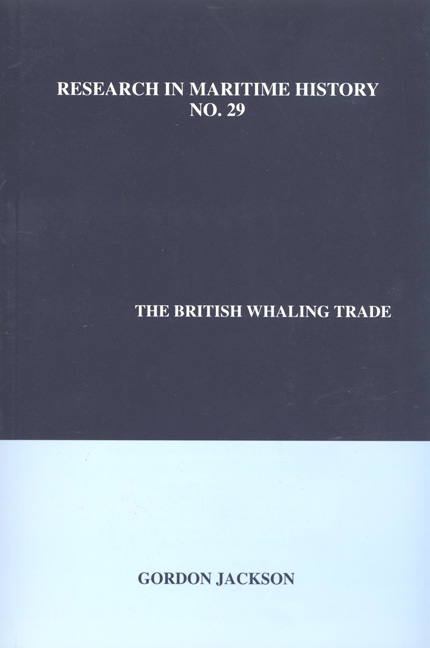Book contents
- Frontmatter
- Dedication
- Contents
- List of Tables in the Text
- List of Appendices
- New Introduction
- Preface
- Part One The Traditional Whaling Trades, 1604-1914
- Chapter 1 Northern Adventures and the Spitsbergen Trade, c. 1604-1670
- Chapter 2 Lost Hopes and Expensive Failures, c. 1670-1750
- Chapter 3 The Rise of the Greenland Trade, 1750-1783
- Chapter 4 The Boom in the Northern Fishery, 1783-c. 1808
- Chapter 5 Expansion South of the Arctic Seas, c. 1776-c. 1808
- Chapter 6 Decline in the North in the Early Nineteenth Century
- Chapter 7 Expansion and Failure of the Southern Fishery, c. 1808-1840
- Chapter 8 The End of the Northern Fishery in the late Nineteenth Century
- Part Two The Modern Whaling Trade, 1904-1963
- Conclusion
- Appendices
- Select Bibliography
- Additional Bibliography
- Index
Chapter 7 - Expansion and Failure of the Southern Fishery, c. 1808-1840
from Part One - The Traditional Whaling Trades, 1604-1914
- Frontmatter
- Dedication
- Contents
- List of Tables in the Text
- List of Appendices
- New Introduction
- Preface
- Part One The Traditional Whaling Trades, 1604-1914
- Chapter 1 Northern Adventures and the Spitsbergen Trade, c. 1604-1670
- Chapter 2 Lost Hopes and Expensive Failures, c. 1670-1750
- Chapter 3 The Rise of the Greenland Trade, 1750-1783
- Chapter 4 The Boom in the Northern Fishery, 1783-c. 1808
- Chapter 5 Expansion South of the Arctic Seas, c. 1776-c. 1808
- Chapter 6 Decline in the North in the Early Nineteenth Century
- Chapter 7 Expansion and Failure of the Southern Fishery, c. 1808-1840
- Chapter 8 The End of the Northern Fishery in the late Nineteenth Century
- Part Two The Modern Whaling Trade, 1904-1963
- Conclusion
- Appendices
- Select Bibliography
- Additional Bibliography
- Index
Summary
The southern fishery was in no better shape, though it had promised so much at the turn of the century, when it appeared to offer limitless regions for the exploitation of the more valuable sperm whale. In fact, after the major expansion of the 1790s, the Southern Fishery stagnated in comparison with the Northern Fishery, which expanded both its catches and value with the opening up of the Davis Straits grounds. Between 1804-1805 and 1814-1815 the tonnage of Northern whalers grew by sixty-six percent, whereas that of Southern whales actually declined by twenty percent as the trade was forced to make time because of the troubles created by war. Whalers going south-east were disturbed on the Cape of Good Hope fishery, at least four being captured by the Dutch and taken into Capetown in 1804 alone. Whalers going south-west faced the historic difficulties of navigating and victualling in Spanish wasters. The chief Pacific sperm fisheries were still off the coasts of Chile, Peru and California, and around the Galapagos Islands and most of the victualling places, so vital for the Pacific trade, were in Spanish territory: Concepcion and Valparaiso in Chile, Lima and Payta in Peru, and Guayaquil in Ecuador. Captains were once more reluctant to double the Horn, though equally dangerous was the long haul through the south Atlantic for ships that missed the St. Helena Convoy.
Faced with naval conflicts that were reminiscent of Spitsbergen two centuries earlier, owners armed their ships or withdrew them from danger areas. The sister ship Caerwent and Cambridge, for instance, were heavily armed and provided with letters of marque before being sent round the Horn to hunt as a pair for both whales and shipping. When eventually they came across a Spanish schooner they plundered it in such a drunken and disorderly manner as to endanger the crews and ships falling into the hands of the enemy, and the captains were forced to draw up a set of regulations for the plundering of enemy vessels. Other ships were less fortunate and fell to Spanish, French and Dutch ships, while the outbreak of war with the United States brought that country's frigates out to the whaling coasts to preserve their own whalers and attack the British ones.
- Type
- Chapter
- Information
- The British Whaling Trade , pp. 119 - 128Publisher: Liverpool University PressPrint publication year: 2004



